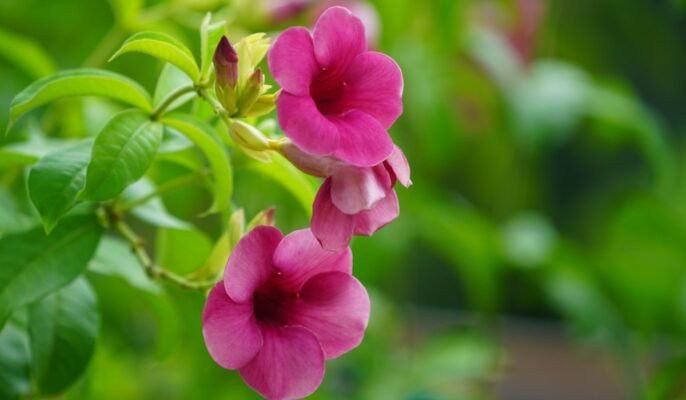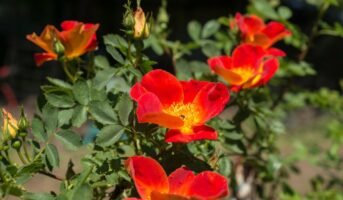What is Allamanda blanchetii?
A species of perennial blooming plant from the Apocynaceae family that is endemic to Brazil is called Allamanda blanchetii. It is cultivated as an ornamental plant and produces large, spectacular rose-purple trumpet blooms that measure 7 to 10 cm wide. Flowers feature five rounded, somewhat overlapping petals that range in hue from pink to reddish purple and are more vibrant near the throat. They emerge from burgundy-brown buds and shine out against the glossy, brilliant green, four-whorled leaves that are 7–12 cm long.
It is popularly known as purple allamanda. It blooms on fresh growth and may either be grown as a vine or trimmed into a dense shrub. Native to Brazil, purple allamanda is a well-liked garden plant in India. Endemic to the jungles of southern Mexico.
Source: Pinterest
See also: How to grow Hydrangea?
Allamanda blanchetii: Facts
| Botanical name: Allamanda blanchetii |
| Type: A small shrub |
| Leaf type: The leaves are Green |
| Flower: Yes |
| Height: 3-5 m tall |
| Season: Summer |
| Sun exposure: Keep in the shade with a few hours of direct sunlight |
| Ideal temperature: 70 to 90 degrees Fahrenheit |
| Soil type: Well-drained |
| Soil pH: Slightly acidic to slightly alkaline |
| Basic requirements: Intermittent watering, indirect sunlight, home-made fertiliser |
| Ideal location for placement: Outdoors |
| Ideal season to grow: Summer |
| Maintenance: Low |
How to grow and care allamanda blanchetii
Grow
- Allamanda blanchetii is a plant that grows up to 15 feet in height. It requires full sun, but it can tolerate partial shade as well.
- The soil should be well drained and slightly acidic, with a pH between 6 and 7.5.
- The plant will grow best in a pot with good drainage, especially if you are trying to grow it indoors. It can also be planted in some attractive containers if you want to bring it outside for the summer months.
- If you need to fertilise your Allamanda blanchetii plant, do so during the winter months when there is no risk of fungus growth on your foliage.
- You can use an organic fertiliser designed specifically for houseplants or fish emulsion products. When the dead leaves surrounding the base of your plant begin to turn yellow or brown, you should also remove them. They could attract slugs which can cause damage.
Care
- The Allamanda blanchetii plant needs regular maintenance in order to thrive.
- Just enough water should be put into the soil to keep it moist but never waterlogged.
- Throughout the growing season, water your Allamanda blanchetii plant frequently but avoid drowning it. It will cause rot and disease problems for your plants. The plant’s leaves will fall off if they aren’t given enough water. During the winter, irrigation should be minimised.
- During the growth season, fertilise the Allamanda blanchetii plant twice a month using a water-soluble fertiliser designed for flowering plants.
Source: Pinterest
Allamanda blanchetii: Uses
The lovely, adaptable Allamanda blanchetii tropical plant does well as a potted plant as well as climbing a trellis or crawling over an arbour. It is a pleasant addition to gardens for butterflies and pollinators.
Allamanda blanchetii: Toxicity
Though there’s no concrete evidence, Allamanda blanchetii plant is considered toxic. If consumed, it might lead to vomiting, diarrhoea, and even dermatitis, if it comes in contact with the skin.
FAQs
Where did Allamanda blanchetii originate?
Allamanda blanchetii is native to Brazil.
Does Allamanda blanchetii have any medical uses?
No, Allamanda blanchetii does not have medicinal value.
Housing News Desk is the news desk of leading online real estate portal, Housing.com. Housing News Desk focuses on a variety of topics such as real estate laws, taxes, current news, property trends, home loans, rentals, décor, green homes, home improvement, etc. The main objective of the news desk, is to cover the real estate sector from the perspective of providing information that is useful to the end-user.
Facebook: https://www.facebook.com/housing.com/
Twitter: https://twitter.com/Housing
Email: editor@housing.com

